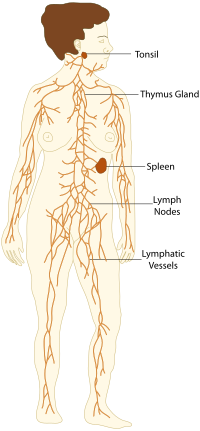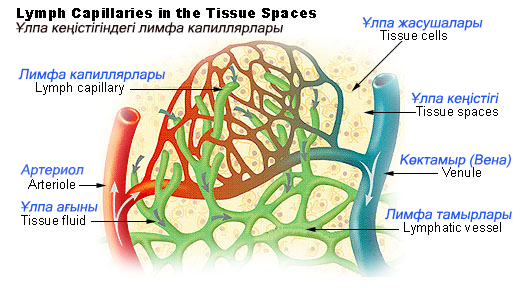Medical Terminology for Cancer
© Copyright 1996-2013
9: The Lymphatic and Immune Systems
Contents
 Functions of the lymphatic system
Functions of the lymphatic system Components of the lymphatic system
Components of the lymphatic system Circulation of tissue fluids
Circulation of tissue fluids The Immune System
The Immune System Cancer Focus
Cancer Focus Roots, suffixes, and prefixes
Roots, suffixes, and prefixes Related Abbreviations and Acronyms
Related Abbreviations and Acronyms Further Resources
Further ResourcesFunctions of the lymphatic system
The key functions of the lymphatic system:- Drains excess fluids and proteins from tissues all around the body and returns them back into the bloodstream.
- Removes waste products produced by cells.
- Fights infections.
- Absorbs fats and fat-soluble vitamins from the digestive system and transports these into the bloodstream.
Components of the lymphatic system

Immage source: Wikimedia License: CC-BY-3.0 |
|
The major (encapsulated) lymphatic organs are the lymph nodes, thymus and spleen. In addition the lymphoid tissues include:
- Mucosa-associated lymphoid tissue (MALT)
- These are bundles of lymphatic cells, called lymphatic nodules, located within the mucus membranes that line the gastrointestinal, respiratory, reproductive, and urinary tracts. These nodules contain lymphocytes and macrophages which defend against invading bacteria and other pathogens that enter these passages along with food, air, or urine. These nodules can be solitary or grouped together in clusters.
Major clusters of lymphatic nodules include:
- Tonsils: these are clusters of lymphatic tissue under the mucous membrane lining of the nose, mouth, and throat. Lymphocytes and macrophages in the tonsils provide protection against foreign substances and pathogens that enter the body through the nose or mouth.
- Adenoids: A cluster of lymphatic tissue that hangs from the upper part of the back of the nasal cavity. Adenoids get bigger after birth but usually stop growing by the age of 7. Like the Tonsils, they can be removed without significantly increased risk of infections.
- Peyer's patches: these are clusters of lymphatic nodules in the mucosa that lines the ileum of the small intestine. They play an important role in defending against the large number of pathogens that enter the gastrointestinal system.
Circulation of tissue fluids

Fluid in the spaces between tissues is called interstitial fluid, or 'tissue fluid'. This provides the cells of the body with nutrients (via the blood supply) and a means of waste removal. Lymph is formed when the interstitial fluid is collected through tiny lymph capillaries (see diagram), which are located throughout the body. It is then transported through lymph vessels to lymph nodes, which clean and filter it. Lymph then flows on to the lymphatic ducts, before emptying into the right or the left subclavian vein, where it mixes back with blood.
Blood is enriched with oxygen (by the respiratory system) and nutrients (by the digestive system), which are circulated all around the body (by the cardiovascular system). Some fluid (blood plasma) leaks out into the tissues via tiny capillaries, contributing to interstitial fluid, which eventually drains back into the lymphatic system.
The Immune System
The immune system includes a variety of defenses against viruses, bacteria, fungal infections, and parasites (such as thread worms). The lympatic system is part of the broader Immune System.
- Innate immune system
-
This are the non-specific, unchanging lines of defenses which include:
- Physical and chemical barriers to pathogens.
- Producing cytokines and other chemical factors to recruit immune cells to sites of infection.
- Activates the complement cascade to identify bacteria, activate cells and to promote clearance of dead cells or antibody complexes.
- Identifies and removes foreign substances present in organs, tissues, the blood and lymph, by specialised white blood cells.
- Activation of the adaptive immune system, through a process known as antigen presentation.
- Adaptive immune system
- Adaptive (or acquired) immunity is where immunological memory is made after an initial response to a new pathogen, leading to an enhanced response to future exposure to that same pathogen. This process of acquired immunity is the basis of vaccination. This is essential because bacteria and viruses are continually adapting and evolving in an 'arms race' with our immune systems. Features of the adaptive immune system include:
- Recognition of specific "non-self" antigens, during the process of antigen presentation.
- The generation of responses tailored to destroy specific pathogens or pathogen-infected cells.
- Development of immunological memory, in which each pathogen is "remembered" by signature antibodies or T cell receptors. These memory cells can be called upon to quickly eliminate a pathogen should subsequent infections occur.
- Cells of the Immune System
-
There are many different cell types and sub-types involved in the immune system. Some of the main types include:
- Lymphocytes: are white cells which circulate between blood and lymph. They play an important role in fighting infection. There are many kinds of lymphocytes; the main types are T cells, B cells and natural killer cells. Lymphocytes initially develop in the bone marrow. Some migrate to the thymus, where they mature into T cells ; others mature in the bone marrow as B cells.
- Neutrophils: are the most abundant type of white blood cells and are an important part of the innate immune system. Neutrophils are a type of phagocyte (cells which engulf and then digest, cellular debris and pathogens). They are normally found in the blood stream, but are quickly recruited to the site of injury or infection following chemical signals such as Interleukin-8.
- Macrophages: are another type of phagocyte and have a role in both the innate and adaptive immune systems. They attack foreign substances, infectious microbes and cancer cells. Macrophages also stimulate lymphocytes and other immune cells to respond to pathogens.
- Dendritic cells: are antigen-presenting cells which act as messengers between the innate and adaptive immune systems. They are usually located in tissues in contact with the external environment such as the skin, linings of the nose, lungs, stomach and intestines. In response to pathogens they migrate to the lymph nodes where they interact with T cells and B cells to initiate the adaptive immune response.
- Antigens and Antibodies
- Antibodies (also known as an immunoglobulins) are Y-shaped proteins produced by B-cells,that bind to specific antigens on the surface of foreign objects such as bacteria and viruses. This identifies and 'tags' the foreign object as 'non-self', signalling other immune cells to attack them.
- Hormones and the Immune System
- There are several hormones generated by the immune system. These hormones are generally known as lymphokines. Steroids and corticosteroids (components of adrenaline) suppress the immune system.
Cancer Focus
- Metastatic spread of cancer via the lymph nodes
- Lymph nodes close to the primary tumor are often the first site of metastases (spread of cancer). Lymph node metastases are rarely life threatening, but their detection is a prognostic factor for many types of cancer as it shows the tumor has developed the ability to spread. Tumor cells may travel via the lymphatic system and spread to to lymph nodes and distant organs.
- Sentinel Lymph Node Biopsy
- A dye is injected near the primary tumor to identify the position of the sentinel lymph node (the first lymph node to which cancer cells are most likely to spread as the lympatic system drains fluid away from the tumor). The sentinel node is surgically removed and a pathologist checks for the presence of cancer cells. SLNB is most frequently used to help stage breast cancer and melanoma. It is a less extensive operation compared to standard lymph node surgery.
- Immunosuppression
- This is reduced activity or efficiency of the immune system and its ability to fight infections and other diseases. Certain diseases such as AIDS or lymphoma can cause immunosuppression. It is also a common side-effect of anticancer chemotherapy, leading to cancer patients having an increased risk of infections during treatment.
- Lymphoma
- A general term form for malignant disease of the lymphatic tissue characterized by abnormal, uncontrolled cell growth. There are a number of types of lymphoma, including Hodgkin Lymphoma, with most other types classed together as Non-Hodgkin Lymphoma.
- Hodgkin Lymphoma
- A malignancy of the lymphatic tissue that occurs most often in males, and the peak incidence is between ages 15 and 35. It is characterised by progressive, painless enlargement of the lymph nodes, spleen, and general lymph tissue. In Hodgkin Lymphoma Reed-Sternberg cells (a specific type of lymphocyte) become abnormal and grow in an uncontrolled way.
 Internet Resources for Hodgkin Lymphoma
Internet Resources for Hodgkin Lymphoma
- Non Hodgkin Lymphoma (NHL)
- NHL is cancer of the lymphatic tissue, that does not involve abnormal Reed-Sternberg cells (a specific type of lymphocyte). There are many different types of NHL. Some grow very slowly, whilst others grow quickly and need aggressive treatment.
 Internet Resources for NHL
Internet Resources for NHL
- AIDS related lymphoma
- Incidence of non-Hodgkin's lymphoma has increased in parallel with the AIDS epidemic. Lymphomas affecting HIV infected people are mostly of the aggressive B-cell types (diffuse large cell, B-immunoblastic, or small non-cleaved Burkitt's / Burkitt's like lymphoma) which are less common in non-HIV infected lymphoma patients. The HIV virus is not thought to a direct cause of lymphoma, rather it weakens the body's defences and may increase susceptibility to other infections such as the Epstein-Barr and HHV-8 viruses which are associated with these types of lymphomas.
 Internet Resources for AIDS related Lymphoma
Internet Resources for AIDS related Lymphoma
- Waldenstrom's Macroglobulinemia
-
This is a rare malignant condition, involving an excess of beta-lymphocytes (a type of cell in the immune system) which secrete immunoglobulins (a type of antibody). WM usually occurs in people over sixty, but has been detected in younger adults.
 Internet Resources for Waldenstrom's Macroglobulinemia
Internet Resources for Waldenstrom's Macroglobulinemia
- Cancer Immunotherapy
- This is treatment to stimulate the patient's own immune system to attack the cancer cells. Different approaches include: 1) cancer vaccination to train the immune system to recognise the cancer cells as targets to be destroyed, 2) giving therapeutic antibodies to recruit immune system cells to destroy tumor cells, and 3) cell based immunotherapy which is either transfusing immune cells (such as Natural killer Cells) or by administering cytokines (such as Interleukins) which activate the immune cells.
- HPV Vaccination and Cervical Cancer
-
Human papillomavirus (HPV) is a common cause of infection. There are over 100 different sub-types of HPV. HPV types 16 and 18 cause 70% of cervical cancers and are also linked to cancers of the anus, vulva, vagina, penis, as well as the mouth and throat. Over time these can cause cells in the cervix to change, leading to precancerous conditions - cervical intraepithelial neoplasia (CIN), with a higher risk of developing cancer. Vaccination against HPV 16, 18 and other 'high risk' types of HPV reduces the risk of developing cervical and other HPV-related cancers.
 Internet Resources for HPV Vaccination and Cervical Cancer
Internet Resources for HPV Vaccination and Cervical Cancer
- Lymphedema
- Lymphedma is an abnormal build up of interstitial fluid due to problems in the lymphatic system. It can have many causes. In the context of cancer it is often a result of obstruction by a tumor or enlarged lymph nodes. It can also be a side effect of radiotherapy or surgery, which has damaged the lymph vessels.
Roots, suffixes, and prefixes
Most medical terms are comprised of a root word plus a suffix (word ending) and/or a prefix (beginning of the word). Here are some examples related to the Lymphatic and Immune systems. For more details see Chapter 4: Understanding the Components of Medical Terminology
| component | meaning | example |
| aden(o)- | gland | Lymphadenopathy - disease of, or swelling/enlarged lymph nodes |
| immun(o)- | Immunity | Immunosuppression = reduced activation or efficacy of the immune system |
| lymph(o)- | Lymph | Lymphoma = tumour of lymphoid cells |
| lymphaden(o)- | lymph node | Lymphadenectomy = surgical removal of lymph node(s) |
| lymphangi(o)- | lymphatic vessels | Lymphangitis = inflammation or infection of the lymphatic vessels |
| splen(o)- | spleen | Splenomegaly = enlargement of the spleen |
| thym(o)- | thymus | Thymectomy = surgical removal of the thymus |
| tox(o)- | poison | Immunotoxicity = adverse effects on immune system function resulting from exposure to chemical substances. |
Related Abbreviations and Acronyms
| AIDS | Acquired Immunodeficiency Syndrome |
| EBV | Epstein-Barr virus |
| HD | Hodgkin's Disease (now known as Hodgkin Lymphoma) |
| HIV | Human Immunodeficiency Virus |
| HPV | Humapapillomavirus |
| HSV | Herpes Simplex Virus |
| IgA | Immunoglobulin A |
| IgD | Immunoglobulin D |
| IgE | Immunoglobulin E |
| IgG | Immunoglobulin G |
| IgM | Immunoglobulin M |
| MALT | Mucosa-associated lymphoid tissue |
| NHL | Non Hodgkin's Lymphoma |
| NKT | Natural killer T cell |
| SLNB | Sentinel Lymph Node Biopsy |
Further Resources (9 links)
National Cancer Institute
Detailed presentation and notes.
 Introduction to the Lymphatic System
Introduction to the Lymphatic System
SEER, National Cancer Institute
Part of a SEER training module for cancer registry staff.
 Lymphatic System - Self Test questions
Lymphatic System - Self Test questions
WebAnatomy, University of Minnesota
Test your anatomy knowledge with these interactive questions. Includes different question types and answers.
 Mechanism of lymph node metastasis in prostate cancer
Mechanism of lymph node metastasis in prostate cancer
Future Oncol. 2010 May;6(5):823-36
Datta K, Muders M, Zhang H, Tindall DJ. Mechanism of lymph node metastasis in prostate cancer. Future Oncol. 2010 May; 6(5): 823-836. (full article available free on PubMed Central)
National Cancer Institute
Factsheet in the form of questions and answers, with references.
 The components of the immune system
The components of the immune system
National Library of Medicine
A section, with diagrams from: Janeway CA Jr, Travers P, Walport M, et al. Immunobiology: The Immune System in Health and Disease. 5th edition. New York: Garland Science; 2001.
 The Immune System
The Immune System
Paul Andersen
Paul Andersen explains how your body protects itself from invading viruses and bacteria. He starts by describing the nonspecific immune responses of skin and inflammation. He then explains how we use antibodies to disrupt the function of antigens and mark them for destruction. He then explains both the homoral and cell-mediated immune response highlighting the importance of B and T lymphocytes. He finally describes the process of long term immunity.
Cancer Research UK
Short overview, with diagrams.
 Your Immune System 101: Introduction to Clinical Immunology
Your Immune System 101: Introduction to Clinical Immunology
UCSF
Dr. Katherine Gundling, Professor, Division of Allergy and Immunology at UCSF presents an overview of the immune system, how it functions and what can go wrong.



This guide by Simon Cotterill
First created 4th March 1996
Last modified: 1st February 2014


 CancerIndex
CancerIndex